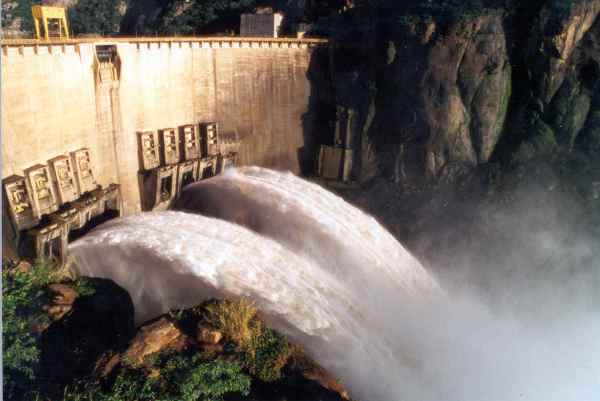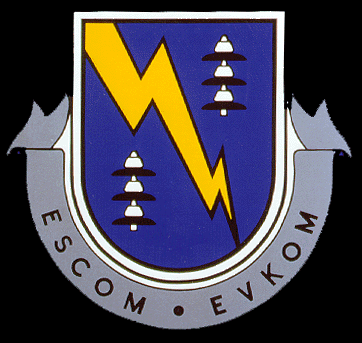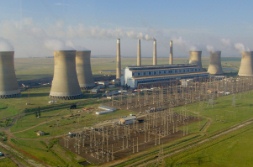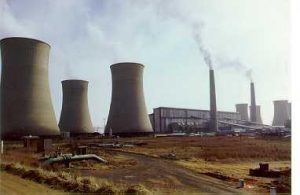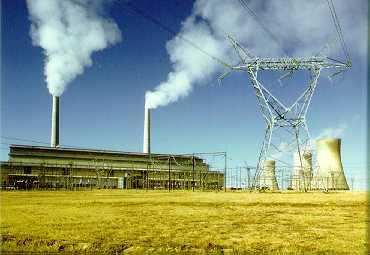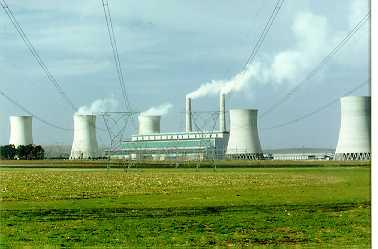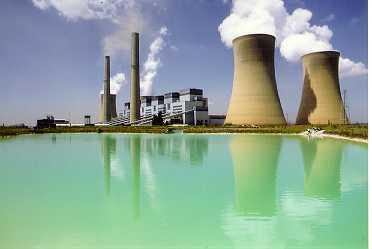The reheat technology was finally used on Arnot power station, which began commercial service in 1971. As a result of this improved technology, steam pressure increased from 10 MPa to 16 MPa, while steam temperature decreased from 538°C to 510°C. The lower temperature meant that less specialised steel was used in the boiler, which led to cost savings and an impressive (forits day) efficiency of 33%. At around the same time, ESCOM also built Grootvlei power station,near Balfour. Grootvlei had to get its water from the already heavily taxed Vaal Dam, and thus, it was the obvious choice for South Africa’s first dry-cooling towers – which were used for Units 5 and 6, while Units 1 to 4 used conventional wet-cooling towers.
As is mostly the case for a power utility, the great x factor in making problems go away and dreams come true was technology. For ESCOM, the late 1960s and early 1970s saw the dream of a national grid come to fruition at last.
Transmission technology had advanced sufficiently. Long transmission lines of 275 kV and 400 kV were now viable. ESCOM went to great lengths to plan an interconnected network: the ultimate pool. The massive difference between coal costs in the Cape and the Eastern Transvaal (R2 a ton versus R7 a ton) was a big factor in pushing things forward. In 1969, ESCOM began constructing the network in 300 km stages. By August 1970, the transmission line running from Camden power station (near Ermelo) to Cape Town had been completed. It took a little longer to connect the Natal and Transvaal systems, as the Orange River Project caused shortages of steel and cement. But a 400 kV line linking Camden and Ingagane was completed in October 1971. A 1971 amendment to the Electricity Act gave ESCOM the authority to amalgamate the power resources of two or more undertakings and to supply electricity from one undertaking to another. This paved the way for the establishment of the Central Generating Undertaking (CGU) on 1 January 1972, which enabled ESCOM to operate all its power stations and other power plants as an integrated system. However, it was only in ESCOM’s 50th year (1973), after extending the network to the Eastern Cape, that a national grid was finally achieved. All ESCOM’s power stations were transferred from the regional undertakings to the CGU (under the expert guidance of Ian McRae).
Pooling meant that ESCOM could benefit from economies of scale, which meant lower electricity prices. The more expensive coastal stations could be used for peak load and emergencies, while the country ran primarily off cheap Highveld coal.
ESCOM could now decommission some older stations, and hence, Brakpan, the VFP’s first power station, was closed in 1970. Rosherville, which had also produced compressed air, was decommissioned in 1966 and turned into a central workshop complex. The mines then made their own compressed air. Meanwhile,
Simmerpan, which had been the VFP’s control centre since 1912, received a revamp in 1968 becoming the control centre for the entire country’s grid featuring world-class communications technology. It was also the site for laboratories and workshops for monitoring and maintaining the transmission network.
The national grid brought cost-saving economies of scale into the system, which meant that municipalities were better off abandoning their own base load power generation and rather looked at buying in bulk from ESCOM. The Johannesburg City Council tried to buck the trend in 1969 when it applied to build its own 1 000 MW power station. In the end, it could not secure permission to do so, and this was the last time a South African municipality applied to build its own base load station.
South Africa had shown that a national grid was the best way to utilise power resources for the benefit of the entire country. The next step would obviously be to connect the entire region. This is yet to happen in any meaningful sense, but back in 1964, the South African Parliament recognised the opportunity of regional power integration. The Electricity Act was amended to authorise ESCOM to supply electricity in bulk to “adjoining territories”. So it was that, in 1967, Lesotho received ESCOM power via an 88 kV line from Ladybrand in the Free State. The border town of Ressano Garcia in Mozambique received ESCOM power in 1969, and in 1972, a 275 kV line, supplying 20 MW, began sending electricity to the capital, Lourenço Marques (now Maputo). Swaziland began receiving ESCOM power in 1973.
Plans were also afoot to send power in the other direction. In the 1960s, the Portuguese and South African governments began plans to dam the mighty Zambezi River in the north of Mozambique.
The ideal spot for this was a narrow gorge known as Cabora Bassa (later changed to Cahora Bassa after the Komati accord had been signed), situated in Tete Province. It was reckoned that Cabora Bassa could produce as much as 4 000 MW, and in 1969,the SouthAfrican and Portuguese governments signed a contract which gave the go-ahead for the damming of the Zambezi River and locked South Africa into buying 680 MW in 1975 and 1 500 MW by 1980 at a rate of 0.3 c per kWh. It was slow progress negotiating with the Portuguese, and the civil war in Mozambique meant this was always going to be a tricky project. However, things were progressing rather more smoothly with a local hydroelectric project. In 1966, excavations began on the Hendrik Verwoerd Hydro Station (now known as Gariep). Five years later (1971), the station started feeding power into the grid. On completion, Hendrik Verwoerd would add 360 MW to the grid and provide the country with useful back-up in the event of emergencies and peak demand. Unfortunately, South Africa is not well suited to the development of hydroelectric power, and when it comes to finding alternatives to coal, nuclear provides better potential. In the early 1960s, the government had already approved an atomic energy research and development programme, and this received a boost when a research reactor, known as Safari and supplied by the US, was installed at Pelindaba. Scientists and engineers were sent overseas for training, and research continued under the auspices of the Atomic Energy Board (AEB).
In 1966, ESCOM purchased the farm Duynefontein, 30 km outside of Cape Town, as a possible site for a nuclear power station. In 1972, the decision was made to construct Koeberg nuclear power station at that site.
By that stage, the country was facing an oil embargo from the Arab states, and the government was understandably fearful of running out of energy. There was also the matter of nuclear weapons. No one is sure whether South Africa’s nuclear energy programme was driven by the government’s desire to equip itself with an atomic bomb – but in any event, in the same year that ESCOM decided to build Koeberg, the government initiated a nuclear weapons programme. Happily; South Africa dismantled its nuclear weapons in the 1990s, and Koeberg continues to supply the country with 1 840 MW of energy. Meanwhile, the 1960s saw high levels of growth for the South African economy and a steep increase in the demand for power. In 1970, sales rose by 10.7%, the highest surge since 1955. In 1971, ESCOM needed R175 million for its expansion programme, but there was a world shortage of capital, interest rates were high, and South Africa’s reputation as a racist state meant increasing isolation from capital markets. All the hard work ESCOM was putting into bringing down the cost of power was being eroded by the high cost of borrowing. The solution was the 1971 Electricity Amendment Act, which allowed ESCOM to raise capital from its own revenue. ESCOM duly set up a Capital Development Fund (CDF) and began to do just that. The CDF meant that tariffs could be used to build up capital and, thus, protect consumers from large increases in the future.
